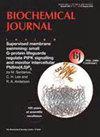De novo talin-1 variant L353F connects multifaceted clinical symptoms to alterations in talin-1 function.
IF 4.3
3区 生物学
Q2 BIOCHEMISTRY & MOLECULAR BIOLOGY
引用次数: 0
Abstract
Talin-1 is a central integrin adapter protein connecting cytoplasmic domains of integrins to the cytoskeleton. These talin-1-mediated mechanical linkages are crucial for cellular functions such as cell movement and connections with other cells. Here, we report a patient carrying a missense variant, L353F, in the talin-1 head which is associated with a complex set of symptoms, including skin lesions, blood cell abnormalities, and congenital cataracts. We conducted structural and cellular characterization of this variant. Recombinant talin-1 F2F3 fragment with the corresponding mutation showed a decrease in thermal stability and decreased solubility. Reconstitution of talin-deficient cells with L353F talin-1 revealed decreased cell migration velocity, defects in wound healing capacity, and changes in recruitment of the focal adhesion complex protein paxillin. We also observed decreased levels of activated integrin in cells expressing the talin-1 variant, while integrin-binding affinity was preserved as determined biochemically. These observations suggest that changes in integrin adhesion complex dynamics reflect cellular processes and the multifaceted patient phenotype.新生talin-1变体L353F将多方面的临床症状与talin-1功能的改变联系起来。
Talin-1是连接整合素细胞质结构域和细胞骨架的中心整合素适配蛋白。这些talin-1介导的机械连接对于细胞功能(如细胞运动和与其他细胞的连接)至关重要。在这里,我们报告了一位talin-1头部携带错义变异L353F的患者,该变异与一系列复杂的症状相关,包括皮肤病变、血细胞异常和先天性白内障。我们对这种变异进行了结构和细胞表征。突变后的重组talin-1 F2F3片段热稳定性下降,溶解度下降。用L353F talin-1重建talin缺陷细胞,发现细胞迁移速度下降,伤口愈合能力缺陷,局灶黏附复合体蛋白paxillin的募集发生变化。我们还观察到,在表达talin-1变异的细胞中,活化的整合素水平下降,而整合素结合的亲和力则被保留下来。这些观察结果表明,整合素粘附复合物动力学的变化反映了细胞过程和多方面的患者表型。
本文章由计算机程序翻译,如有差异,请以英文原文为准。
求助全文
约1分钟内获得全文
求助全文
来源期刊

Biochemical Journal
生物-生化与分子生物学
CiteScore
8.00
自引率
0.00%
发文量
255
审稿时长
1 months
期刊介绍:
Exploring the molecular mechanisms that underpin key biological processes, the Biochemical Journal is a leading bioscience journal publishing high-impact scientific research papers and reviews on the latest advances and new mechanistic concepts in the fields of biochemistry, cellular biosciences and molecular biology.
The Journal and its Editorial Board are committed to publishing work that provides a significant advance to current understanding or mechanistic insights; studies that go beyond observational work using in vitro and/or in vivo approaches are welcomed.
Painless publishing:
All papers undergo a rigorous peer review process; however, the Editorial Board is committed to ensuring that, if revisions are recommended, extra experiments not necessary to the paper will not be asked for.
Areas covered in the journal include:
Cell biology
Chemical biology
Energy processes
Gene expression and regulation
Mechanisms of disease
Metabolism
Molecular structure and function
Plant biology
Signalling
 求助内容:
求助内容: 应助结果提醒方式:
应助结果提醒方式:


